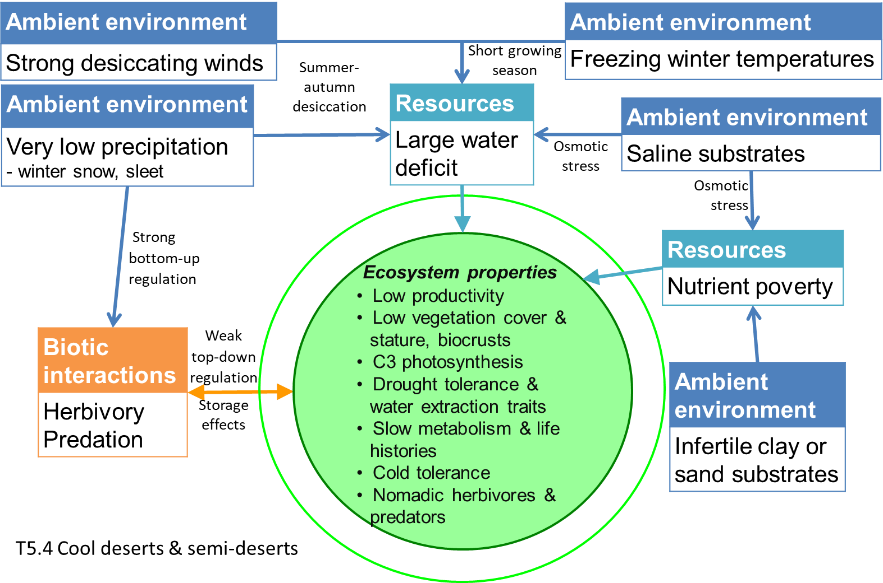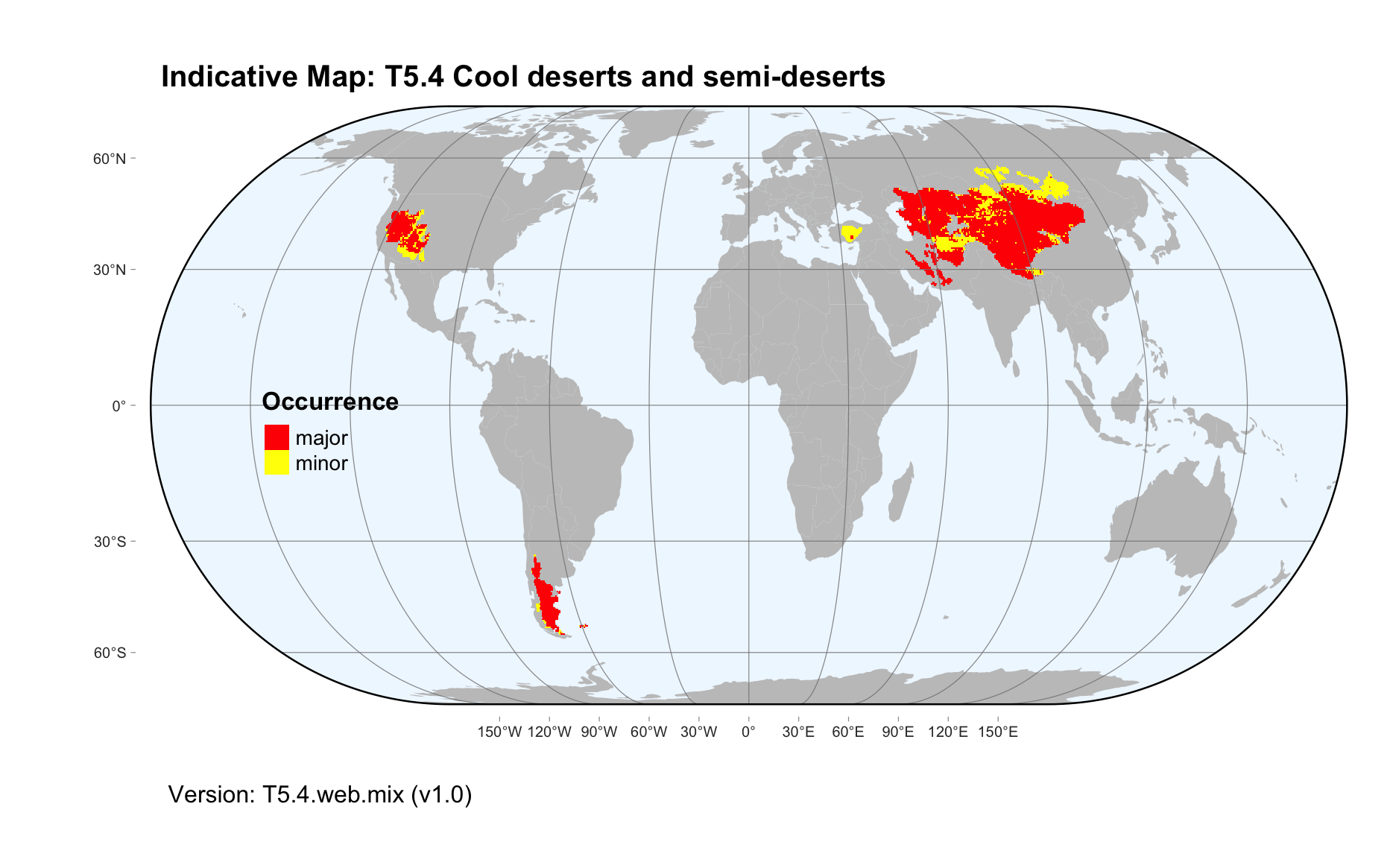Global ecosystem typology
Alternative site for the Global ecosystem typology with additional information for ecosystem profiles and indicative maps.
This site is maintained by jrfep
T5.4 Cool deserts and semi-deserts
Biome: T5. Deserts and semi-deserts biome
Contributors:
(texts)
Cool deserts and semi-deserts occur on cool temperate plains and plateaus in central Eurasia and temperate parts of the Americas from sea level up to 4,000 m. Strong winds and freezing temperatures prevail, with low annual precipitation falling as winter snow or sleet. Productivity is low on infertile sandy and clay soils, often with high salinity. Vegetation comprises a sparse cover of low grasses and dwarf shrubs, interspersed with bare patches, with some areas having only lichens and mosses or no vegetation at all. Fauna includes large nomadic herbivores including antelopes, wild horses and camels, which control composition of vegetation. Predators include raptors, snakes, bears, and cats.
Key Features
Xeromorphic suffratescent or non-sclerophyll shrublands or grasslands; freezing temperatures in winter low, rainfall offset by reduced evapotranspiration burdon; low diversity and endemism.
Overview of distribution
Cool temperate plains and plateaus from sea level to 4,000 m elevation in central Eurasia, western North America, and Patagonia. Extreme cold deserts are placed in the polar/alpine biome.
Profile versions
- v1.0 (2020-01-20): MG Tozer; D Faber-Langendoen; DA Keith
- v2.0 (2020-05-31): MG Tozer; DJ Eldridge; D Faber-Langendoen; DA Keith
- v2.01 ():
- v2.1 (2022-04-06): MG Tozer; DJ Eldridge; D Faber-Langendoen; DA Keith Full profile available at official site
Main references
Selected references for this functional group:
Johnson SL, Kuske CR, Carney TD, Housman DC, Gallegos-Graves LV, Belnap J (2012) Increased temperature and altered summer precipitation have differential effects on biological soil crusts in a dryland ecosystem Global Change Biology 18: 2583-2593
West NE (1983) Comparisons and contrasts between the temperate deserts and semi-deserts of three continents Ecosystems of the World vol. 5: Temperate deserts and semi-deserts (Ed. NE West). Elsevier, Amsterdam
Diagrammatic assembly model

Maps
Maps are indicative of global distribution patterns are not intended to represent fine-scale patterns. The maps show areas of the world containing major (coloured red) or minor occurrences (coloured yellow) of each ecosystem functional group. See general notes on maps.
There are 2 alternative versions of the indicative map for this functional group, please compare description and sources below.
T5.4.IM.mix_v1.0
Datasets
- EarthEnv-LandCover-v1.0
- Resolve-Ecoregions-2017
Map references
Tuanmu, M.-N. and W. Jetz (2014) A global 1-km consensus land-cover product for biodiversity and ecosystem modeling Global Ecology and Biogeography 23(9):1031–1045 DOI:10.1111/geb.12182
Dinerstein E, Olson D, Joshi A, Vynne C, Burgess ND, Wikramanayake E, Hahn N, Palminteri S, Hedao P, Noss R, Hansen M, Locke H, Ellis EE, Jones B, Barber CV, Hayes R, Kormos C, Martin V, Crist E, Sechrest W, Price L, Baillie JEM, Weeden D, Suckling K, Davis C, Sizer N, Moore R, Thau D, Birch T, Potapov P, Turubanova S, Tyukavina A, de Souza N, Pintea L, Brito JC, Llewellyn Barnekow Lillesø JP, van Breugel P, Graudal L, Voge M, Al-Shammari KF, Saleem M (2017) An Ecoregion-Based Approach to Protecting Half the Terrestrial Realm, BioScience 67: 534–545. DOI:10.1093/biosci/bix014. Data-set available on-line
T5.4.web.mix_v1.0

Datasets
- Resolve-Ecoregions-2017
- EarthEnv-LandCover-v1.0
Map references
Dinerstein E, Olson D, Joshi A, Vynne C, Burgess ND, Wikramanayake E, Hahn N, Palminteri S, Hedao P, Noss R, Hansen M, Locke H, Ellis EE, Jones B, Barber CV, Hayes R, Kormos C, Martin V, Crist E, Sechrest W, Price L, Baillie JEM, Weeden D, Suckling K, Davis C, Sizer N, Moore R, Thau D, Birch T, Potapov P, Turubanova S, Tyukavina A, de Souza N, Pintea L, Brito JC, Llewellyn Barnekow Lillesø JP, van Breugel P, Graudal L, Voge M, Al-Shammari KF, Saleem M (2017) An Ecoregion-Based Approach to Protecting Half the Terrestrial Realm, BioScience 67: 534–545. DOI:10.1093/biosci/bix014. Data-set available on-line
Tuanmu, M.-N. and W. Jetz (2014) A global 1-km consensus land-cover product for biodiversity and ecosystem modeling Global Ecology and Biogeography 23(9):1031–1045 DOI:10.1111/geb.12182
Check: the Glossary / Profile structure / the public document